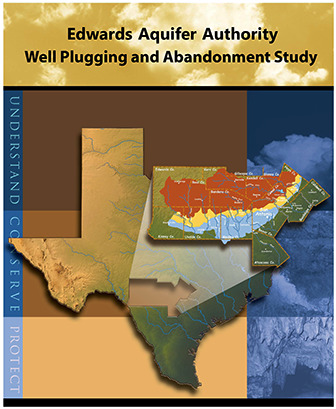Edwards Aquifer Authority Well Plugging and Abandonment Study

| Summary |
|
EAA regulations require plugging of abandoned wells, including either removal of existing casing or perforation of the well casing and subsequent sealing of the annular space. Prior to implementation of EAA regulations, wells were commonly abandoned by filling of the well bore and casing with cement or grout and ignoring the annular space. Poor sealing of the annular space of wells, either during drilling or plugging, has the potential to contribute to groundwater contamination. This study was developed to evaluate the effectiveness of current well-plugging methodology required in the EAA’s rules when applied to Edwards Aquifer wells. The study involved: • Applying a suite of geophysical logging tools to an Edwards Aquifer well before plugging to identify depths at which little or no annular seal was present. • Subsequent perforation of well casing at selected depths with perforation intervals on the basis of results of geophysical logging. • Sealing of well bore and annular space, redrilling of well bore, relogging of well to ascertain quality of cement seal, and final abandonment of the well. Geophysical tools, including a three-arm caliper, natural gamma, DHC, FWS, and nuclear (compensated gamma–gamma density and neutron) tools, were used to evaluate the effectiveness of current well-plugging practices for the protection of water quality. The caliper, the DHC, and the natural gamma tools provided an assessment of the inside condition of the casing, but they were unable to evaluate the condition of the annular space between the outside of the casing and geologic formations. The FWS tool may provide some insight into the annular seal of a well; however, it does not appear to have the resolution or reliability of the nuclear tools. The compensated gamma–gamma density and neutron source tools provided a means of evaluating the condition of the annular seal, as well as a delineation of voids in the annular space. Additionally, the CDL seemed to be more useful in void detection in the annular space, requiring both compensated gamma–gamma density and neutron source tools to get the job done. These tools can be used within or above the water table without impact to log quality or diagnostic capabilities. W104-265 (Car Lot Well) was selected for this study because it offered a larger diameter casing (six inches) and a longer casing than other wells that have been examined. Perforation points were chosen on the basis of distinctive qualities of the annular seal, as determined from nuclear logs. Two of the perforation locations were selected at intervals in which the annular seal was evaluated as good, and three perforation locations were selected at intervals in which the annular seal was evaluated as poor to nonexistent. The intervals 42 to 88 and 125 to 185 ft are locations at which a good annular seal was suggested. Intervals from 28 to 42, 192 to 222, and 232 to 289 ft were evaluated and estimated to contain 50 to 100% void space. So that the effect of perforations on casing with good annular seal versus casing with 50% or greater void space in the annulus could be compared, perforations were made in both areas. Perforation depths of 53 and 135 ft bgs were selected for “good” annular seal tests, whereas perforations at 30, 193, and 271 ft bgs were selected to test areas with 50% or greater annular void space. Clean, round holes were formed by shaped explosive charges where solid annular material occurred between the casing and the borehole wall. Casing cracked or split in intervals where little or no material occurred in the annular space. Analysis of nuclear logs indicates that plugging of the annular void area through the perforations was highly successful. Postperforation and cementing source logging indicated that a good seal was achieved in areas previously indicating 50% or greater void space, and no significant change was noted for the two areas that indicated a good annular seal. This study showed that grouting of the well using gravity-fed tremmie methods from the bottom to the top provided pressure sufficient to force cement through the perforations in the well casing, creating an adequate annular seal. Decreasing the explosive-charge interval from 50 to 25 ft would increase the likelihood of intersecting an annular void. |
Search for Documents
Advance Search
Explore EAA's Scientific Reports
- All Reports
- Water Quality
- Climatology
- Surface Water / Groundwater Relationship
- Biology
- Springs, Groundwater Discharge
- Archaeology
- RZ Protection
- Aquifer Levels
- Remote Sensing
- Precipitation
- Overview Studies
- Modeling
- Hydrology and Hydrogeology
- History
- Groundwater Recharge, Recharge Zone
- Groundwater Movement
- Geomorphology and Caves
- Weather Modification
- Geology
- Water Use and Conservation
- Geochemistry
- Water Resources Planning and Management
- Floods and Drought
